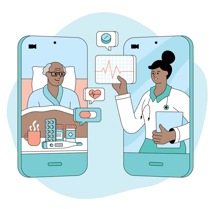Week 7: Course Project – Recommendations
(Week 7: Course Project – Recommendations)
Technology, Society, and Culture
February 18, 2022

Week 7: Course Project – Recommendations
Introduction
Remote patient monitoring (RPM) entails using digital technologies to monitor and obtain medical and other health data of patients in their remote locations or homes and transmit the information electronically to healthcare providers for evaluation needed to develop recommendations and instructions. RPM has seen an increase in adoption, parallel to telehealth, since the beginning of the Covid-19 virus because of the increased need to avoid physical contact in in-patient visits (Mantena & Keshavjee, 2021). RPM is used for patients’ close monitoring and is often deployed as an element of a tiered approach to increase bed availability in healthcare facilities by discharging patients early and monitoring them remotely. Technologies used include wearable devices, symptom surveys, and other digital devices that gather and send information to the practitioner. Remote patient monitoring facilitates monitoring specific patient health aspects from their home, increasing healthcare access and utilization. One primary impact of RPM is increasing convenience by reducing physical contact and unnecessary patient visits (Mantena & Keshavjee, 2021). Generally, the technology is applied for remote monitoring of patient vitals and overall health adopting digital and smart devices, helping with timely disease identification to prevent progression and enhancing care quality and patient safety. Although the primary purpose of RPM is increasing access to healthcare and health service utilization, it is out of reach of some patient populations, including low-income earners and ethnic minorities that experience high poverty rates and live in marginalized areas with limited internet connectivity. Increasing reach is an ethical consideration that would allow all patient populations to enjoy the benefits brought along by RPM. (Week 7: Course Project – Recommendations)
Thesis
Telehealth services, including remote patient monitoring, have been increasingly utilized recently, particularly during and after the COVID-19 pandemic. Telehealth technologies like RPM have become indispensable, helping increase healthcare access and service utilization. However, several ethical issues associated with the practice need addressing to ensure the technology achieves optimal outcomes and fulfils its purpose. RPM poses ethical issues regarding patient autonomy, privacy and confidentiality, equity of access, data security, and erosion of professional-patient relationships. These ethical issues still require standard and particular application rules to ensure equitable access, respect for patient autonomy and privacy and confidentiality, data protection, professional liability, quality of care, and promotion of professional-patient relationships. (Week 7: Course Project – Recommendations)
Ethical Dilemmas
Currently, remote patient monitoring, like other telehealth technologies, could only be adopted as complementary or supplementary care delivery approaches to traditional care delivery because of the ethical issues surrounding the practice. Ethical evaluation of RPM is imperative to promoting its full adoption in healthcare and ensuring a future where RPM becomes integral to everyday healthcare services. RPM poses ethical dilemmas regarding informed consent and autonomy, patient privacy, confidentiality, data security, equitable access, and professional-patient relationship. RPM is increasingly practiced in contemporary healthcare scenarios, and addressing these ethical issues is necessary (Solimini et al., 2021). According to the theory of Principlism, healthcare providers should respect a patient’s autonomy and promote beneficence, non-maleficence, and justice. However, the ethical problems posed by RMP conflict with the theory of Principlism, posing ethical dilemmas for healthcare providers.
Most patients, especially those with chronic conditions, are given guidelines regarding using remote patient monitoring and what devices would aid with disease monitoring and communication with providers. However, patients are not provided information regarding the risks and benefits of remote patient monitoring systems and devices or requested informed consent to engage in remote therapy, which conflicts with the principle of autonomy (Solimini et al., 2021). With RPM, it is difficult for patients, especially older adults, to retain control of who has access to their personal information and health records. RPM increases the risk of patient data being shared or linked without their knowledge, jeopardizing their autonomy, privacy, confidentiality and data security. Noticeably, RPM can make patients more autonomous by getting more involved in their care, but it can also jeopardize autonomy if the information is withdrawn from them regarding the risks and benefits of RPM or who has access to their health data and for what purposes (Solimini et al., 2021). Also, like other digital technologies, RPM increases the risk of data loss through cybersecurity. Without adequate privacy and cybersecurity controls within RPM systems, patient data and communications with care providers can land in unauthorized hands that can harm the patient, conflicting with the principle of beneficence and non-maleficence.
Considerably, RPM’s core purpose is increasing access to healthcare services. Traditional healthcare delivery has presented issues with healthcare access because particular patient populations, including marginalized and rural communities, low-income earners, ethnic and racial minorities, and immigrants, report low healthcare service utilization. Still, RPM poses ethical issues with equitable access to the services as it requires the use of digital devices and reliable internet access, which low-income earners, marginalized and rural communities, and ethnic and racial minorities have limited access to, conflicting with the principle of justice and fairness (Solimini et al., 2021). RPM can only fulfil its purpose and ensure healthcare service access to all if problems with reliable internet connectivity and the cost of using RPM are addressed. Moreover, RPM presents an ethical dilemma regarding the provider-patient relationship because of the loss or reduced face-to-face therapeutic relationships. Face-to-face clinical encounter has a therapeutic value and has been the longstanding premise of the provider-patient relationship (Mehta, 2018). The loss of the physical presence of a provider might eradicate the therapeutic value of provider-patient relationships, and RPM can be limited only to patients with a preexisting relationship with the provider. (Week 7: Course Project – Recommendations)
Recommendations
Promoting patient autonomy is critical to enhancing patient trust in healthcare services and increasing service utilization. Strategies to enhance patient autonomy in RPM systems include clarifying risks, benefits, and expectations of using RPM, enhancing clinical competence in RPM practice, establishing participative decision-making, and improving decision-making competence, including gaining informed consent from patients or caregivers regarding using RPM. The concern over RPM’s threat to patient privacy, confidentiality, and data security is legitimate because patients might not certainly know who they are communicating with or sharing their personal details and health information with. A robust privacy and security plan for any RPM system is required to gain patient confidence, and it should be communicated to the patient (Mehta, 2018). Healthcare organizations should adopt data encryption and other security tools like multiple-factor authentication to ensure patient data and communications do not proliferate (Jalali et al., 2021). Provider and patient training and education on properly using RPM systems and devices are fundamental to eliminating or reducing human errors that lead to security breaches. HIPAA compliance should be adopted for RPM systems in all healthcare scenarios to enhance competence in RPM practice. Furthermore, organizations should secure their wireless networks and messaging systems to reduce the risk of cyber theft (Jalali et al., 2021).
The federal and local governments are responsible for extending reliable internet connectivity, even in remote areas, to increase RPM adoption and utilization. Also, financial aid for struggling populations would facilitate the acquisition of RPM devices. The government can increase grants to non-profit organizations, including American Medical Resource Foundation, MedShare, and Project CURE, helping patients acquire devices for disease management and remote monitoring of vital signs. Finally, RPM can enhance or jeopardize the provider-patient relationship depending on how it is adopted. RPM provides an opportunity to increase healthcare access for patients in geographical areas where reach is limited (Mehta, 2018). It is essential to ensure that RPM and traditional approaches complement each other rather than RPM replacing the traditional face-to-face approach. Providers should engage with patients to determine which visits require an in-person approach and which can be remote. (Week 7: Course Project – Recommendations)
Conclusion
Remote patient monitoring systems have existed for a long time, but their actual adoption increased during the COVID-19 pandemic, and they are now indispensable. Despite the opportunities it presents to enhance healthcare access and service utilization, it also poses ethical challenges and dilemmas that should be considered to ensure optimal RPM adoption. Ethical dilemmas RPM poses include the threat to patient autonomy, privacy, confidentiality, and data security, lack of equitable access, and eroding provider-patient relationships. Addressing these ethical dilemmas is vital for the future of RPM in a more networked and connected world and as people become more comfortable with electronic communication and virtual services. (Week 7: Course Project – Recommendations)
References
Jalali, M. S., Landman, A., & Gordon, W. J. (2021). Telemedicine, privacy, and information security in the age of COVID-19. Journal of the American Medical Informatics Association : JAMIA, 28(3), 671–672. https://doi.org/10.1093/jamia/ocaa310
Mantena, S., & Keshavjee, S. (2021). Strengthening healthcare delivery with remote patient monitoring in the time of COVID-19. BMJ health & care informatics, 28(1), e100302. https://doi.org/10.1136/bmjhci-2020-100302
Mehta, S. J. (2018). Telemedicine’s potential ethical pitfalls. AMA Journal of Ethics, 16(12), 1014-1017. https://journalofethics.ama-assn.org/article/telemedicines-potential-ethical-pitfalls/2014-12#:~:text=Ensuring%20that%20telemedicine%20is%20ethically,new%20technology%20must%20be%20effective.
Solimini, R., Busardò, F. P., Gibelli, F., Sirignano, A., & Ricci, G. (2021). Ethical and Legal Challenges of Telemedicine in the Era of the COVID-19 Pandemic. Medicina (Kaunas, Lithuania), 57(12), 1314. https://doi.org/10.3390/medicina57121314



:max_bytes(150000):strip_icc()/Health-Schizophrenia-Overview-PaigeMcLaughlin-Final-e784ef4214264c8ea708309a09c4901e.jpg)









![Nursing Paper Example on Hepatitis E [SOLVED]](https://cdnrmi-19948.kxcdn.com/sites/default/files/Disease-2020-06/bigstock-Hepatitis-E-Viral-Infection-247374850-e1568915255101.jpg)
![Nursing Paper Example on Hepatitis E [SOLVED]](https://vajiramandravi.s3.us-east-1.amazonaws.com/media/2018/12/18/22/29/26/2.jpg)
